Educator Guide | Prehistoric Road Trip
Educator Guide
About Prehistoric Road Trip
Emily Graslie, host and creator of the popular YouTube series The Brain Scoop, embarks on an epic road trip through America’s fossil country, where she encounters mysterious creatures and bizarre ecosystems that have shaped Earth as we know it. With her trademark sense of adventure and wit, Graslie explores the American West from above and below on an epic journey to better understand our planet’s past and what new discoveries might mean for its future. Prehistoric Road Trip is a production of WTTW.
Major funding for Prehistoric Road Trip is provided by The Negaunee Foundation. Funding is also provided by The Arthur Vining Davis Foundations, The Grainger Foundation, and The Robert Thomas Bobins Foundation.
About Emily Graslie
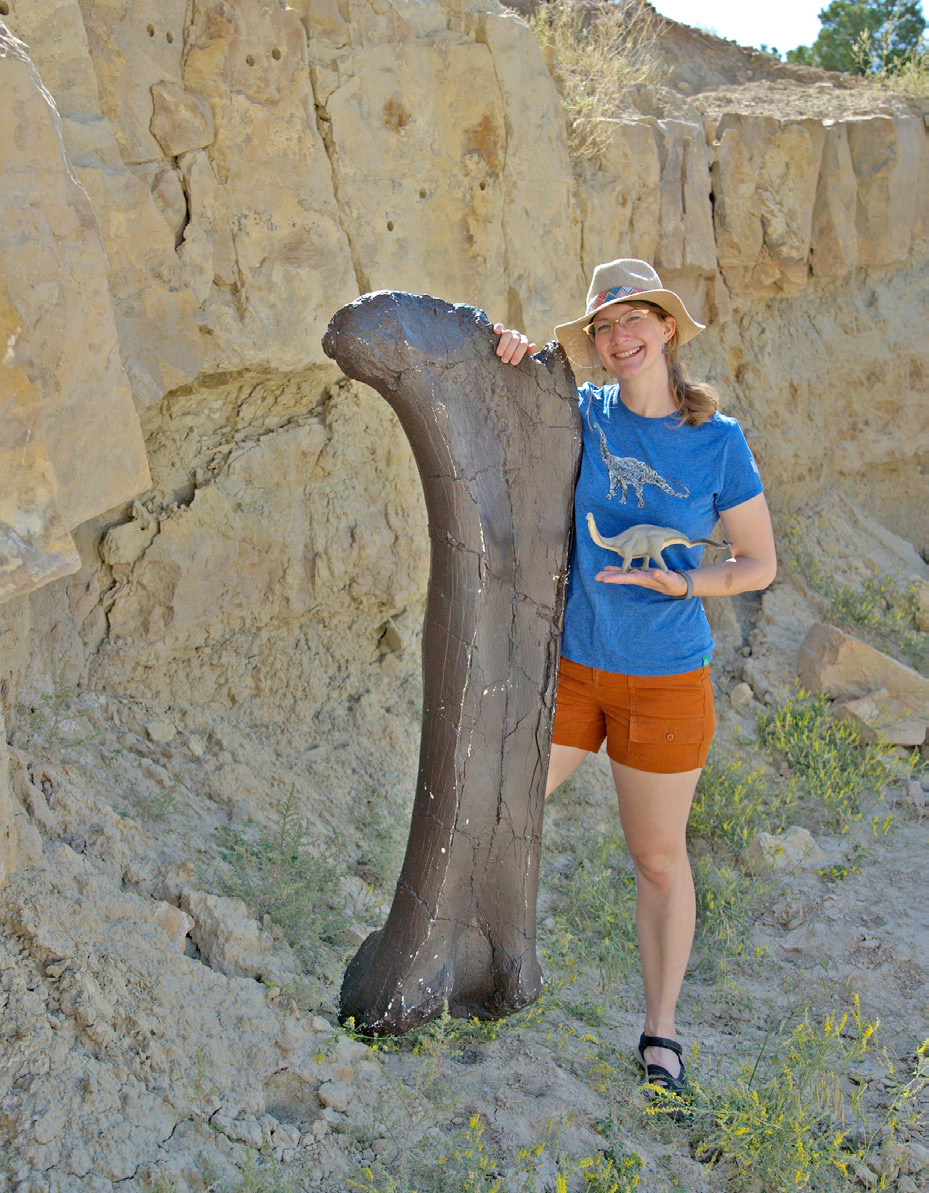
Photo: Julie Florio
Emily Graslie, host, writer, and executive producer, is a native of Rapid City, South Dakota. After moving to Missoula, Montana to pursue an undergraduate fine art degree in painting, Emily fell in love with the campus vertebrate research collection as a place of artistic inspiration. What began as a passionate volunteering position within a small museum eventually morphed into a career as an advocate for these underappreciated repositories. As the Chief Curiosity Correspondent for Chicago’s Field Museum, Emily uses a variety of new media to communicate the importance of natural history museums, including her engaging YouTube channel, The Brain Scoop, which has attracted more than a half-million subscribers.
Emily’s numerous awards and recognitions include the American Alliance of Museum’s Nancy Hanks Award for Professional Excellence. She is a six-time Webby Award recipient; is a member of the 2018 Forbes 30 under 30 list in Education; was named one of the Chicagoans of the Year in the Arts in 2017 by the Chicago Tribune; and has been featured on NPR, CBS News, The Washington Post, Cosmopolitan and more. Scientists at the University of Florida recently named a new species of butterfly in her honor: Wahydra graslieae.
A Letter to Educators from Emily Graslie
Hello, Fellow Learners!
I’ve been out of school for a while, but as Chief Curiosity Correspondent for the Field Museum, I’m lucky to have a job that allows me to pursue many opportunities for lifelong learning. I attribute this to the many teachers and mentors throughout my life that always encouraged me to ask questions, keep an open mind, and pursue new opportunities and experiences. And now I get to share those experiences with you!
I grew up in South Dakota and while I enjoyed visiting different areas of the state, it wasn’t until I grew up and moved away that I really began to appreciate all that region has to offer in terms of its complex geology and geography, as well as the richness of its people’s cultures and histories. Now, as an adult, I wanted to learn more about the special part of the world where I came from.
It’s my hope that students and educators alike will watch Prehistoric Road Trip and discover that both within and outside the walls of your schools—in your neighborhoods, backyards, and beyond—there is so much still left to explore and celebrate about this beautiful world we share together. Every one of you has a unique story to tell about where you come from and the people and places that have shaped you as a person.
Prehistoric Road Trip is my personal homage to a place I called home for a long time. If you wrote an homage to celebrate your own culture, city, or a place special to you, what would you choose to highlight? What stories would you tell? Would you focus on who lives there now—or who lived there many generations ago? Would you write a song about the birds or beetles you see every day—or about the ancient creatures that walked this land long before there were streets and buildings? There are no wrong answers, just as there’s no wrong way to pursue your own interests and curiosities. We all have stories to tell—I can’t wait to hear yours!
And as always—stay curious!
Emily Graslie
Chief Curiosity Correspondent
Field Museum
How to Use This Guide
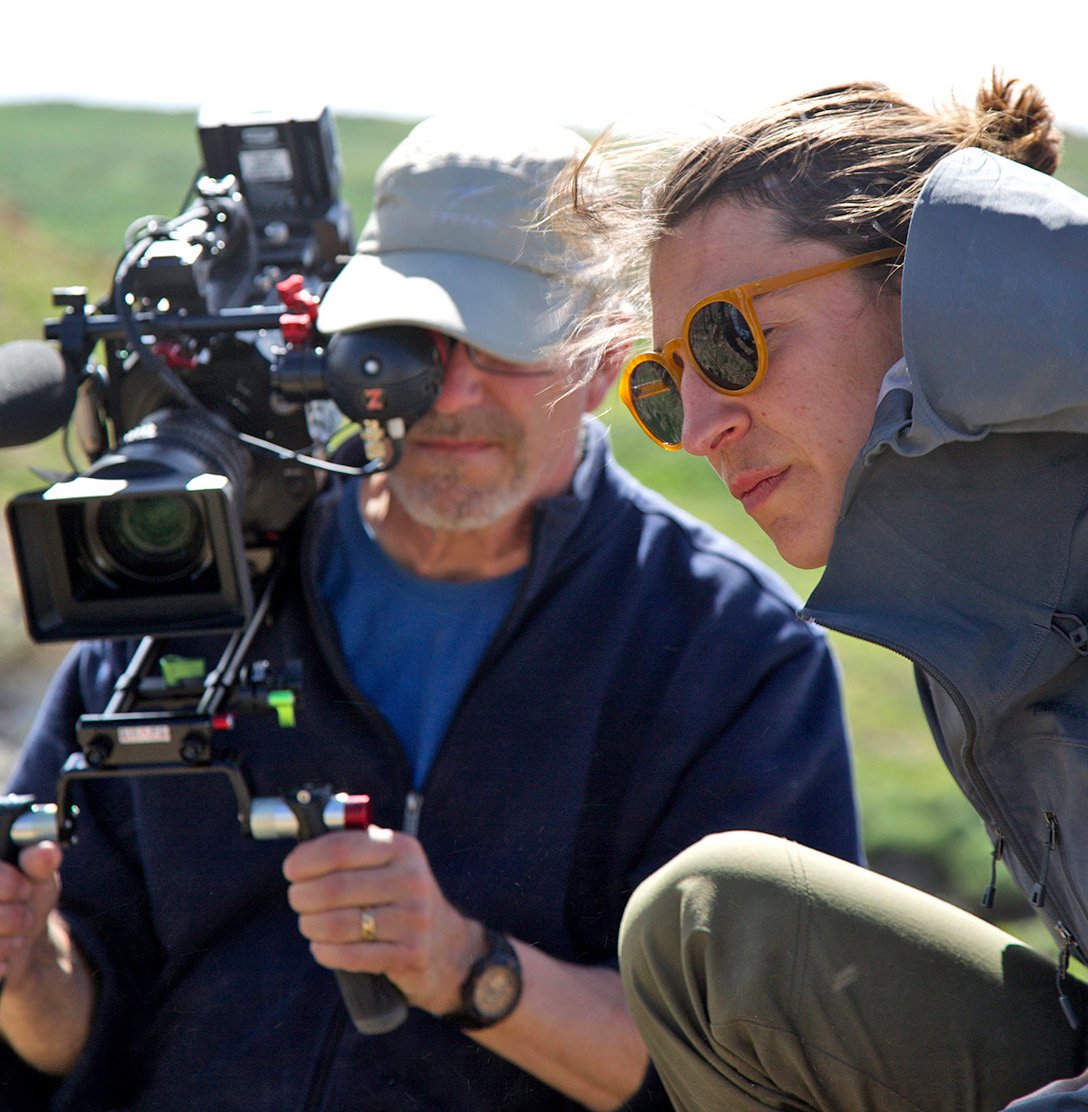
Photo: Raven Forrest/WTTW
Organization
This guide is intended to activate students’ thinking while watching Prehistoric Road Trip and deepen their understanding about Earth’s history and evolution by making connections to the Next Generation Science Standards. Each episode covers a wide range of topics related to geologic history, evolution, and the nature of science. Educators can choose to present each episode in its entirety or select individual segments to highlight concepts or themes that are relevant to their individual curricular needs.
Essential Questions and Connections to Standards
Each essential question strand is connected to Next Generation Science Standards (NGSS) performance expectations and core philosophy for middle school Earth and Space Science and Life Science. These connections are shown in the table on the following page.
|
Essential Questions |
NGSS Connections |
|---|---|
|
How has Earth changed over time? How do we know? |
The middle school performance expectations in Earth and Space Science below build student ideas and skills to explain phenomena in depth. These performance expectations blend core ideas with science practices and crosscutting concepts to support students in understanding Earth’s systems and place in the universe.
|
|
How has life evolved on Earth? How do we know? |
The middle school performance expectations in Life Science below build student ideas and skills to explain phenomena in depth. These performance expectations blend core ideas with science practices and crosscutting concepts to support students in understanding biological evolution through examining unity and diversity.
|
|
What is the nature of science? How does science happen?Who can contribute to science? |
To truly understand the enterprise of science as a whole, students must learn about the constructs and values intrinsic to it. The Next Generation Science Standards articulate eight core understandings of the nature of science:
|
Claim, Evidence, Reasoning, and Wondering Graphic Organizer
To activate and engage students’ critical thinking as they watch Prehistoric Road Trip, encourage students to use the Claim, Evidence, Reasoning, and Wondering Graphic Organizer to record their thinking. Before playing a selected episode segment for students, pre-populate the essential question and guiding question(s) from that portion of the episode guide into the graphic organizer.
To use the Claim, Evidence, Reasoning, and Wondering Graphic Organizer:
- Select the essential question that students will focus on. Then, select appropriate episode chapters to view based on the chapters’ connections to the essential question.
- Record the essential and guiding question(s) in the top portion of the graphic organizer.
- Before viewing, have students develop a claim in response to the guiding question(s).
- While viewing, encourage students to record evidence related to their claim that may affirm or disprove their initial ideas.
- After viewing, prompt students to revisit their claim with the new evidence that they recorded from the episode chapter(s). Allow students to amend their claim based on the evidence, if needed, and then explain their reasoning, articulating how the evidence and claim are connected. Encourage students to record any questions that they now have about the essential or guiding question(s).
- Allow students to use their completed graphic organizer as a reference and recording tool if they engage in one of the suggested discussion strategies.
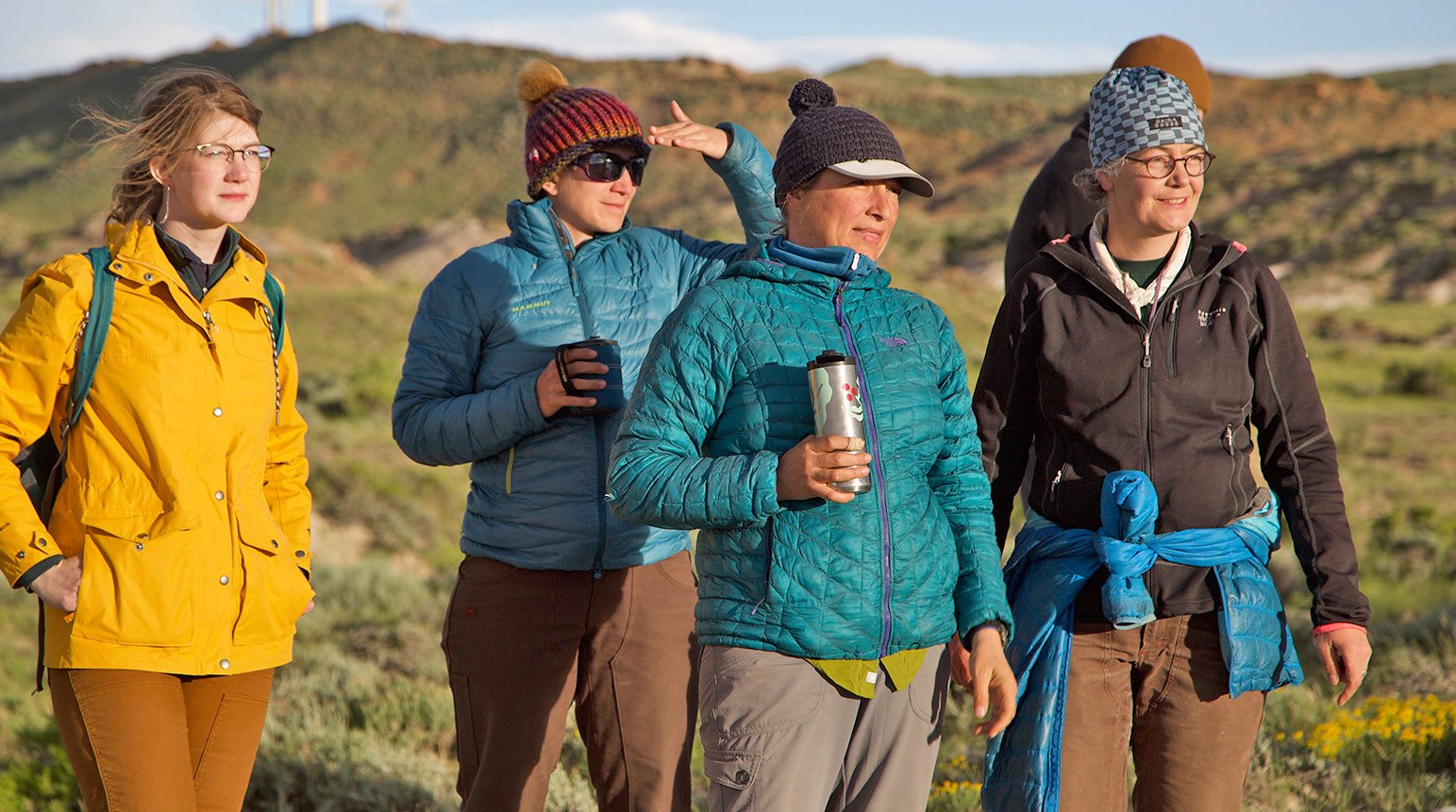
Photo: Raven Forrest/WTTW
Discussion Strategies
When facilitating classroom discussions, allow students to use their completed Claim, Evidence, Reasoning, and Wondering Graphic Organizer as a reference tool. Additionally, consider using one of the discussion formats below to further enhance classroom discussion.
Jigsaw
Select one essential question that the whole class will explore. Break students into small groups. Assign each group to watch one or more of the episode chapters that correspond to the essential question and then complete the Claim, Evidence, Reasoning, and Wondering Graphic Organizer together as a group. Then, mix up students to form new groups composed of individuals who watched different episode chapters. Direct students to take turns sharing their claim, evidence, and reasoning with their new groups and encourage students to add new information or evidence from others to their graphic organizer. Once all students have shared their information, encourage groups to use their collective evidence to revise or refine their claim in response to the essential question.
Socratic circles
Arrange chairs or desks into two concentric circles facing the center. The inner circle should contain approximately one-third of the class seats and the outer circle should consist of the remaining seats. Assign students to sit in the inner circle, and have the remaining students fill in the outer circle. Students in the inner circle will discuss their claim, evidence, and reasoning in response to the essential and guiding questions, using their completed graphic organizer as a reference tool. Students in the outer circle will take notes on the discussion. After five to ten minutes, rotate roles to allow students who were in the outer circle to replace those in the inner circle and pick up the discussion where they left off, adding new claims, evidence, and reasoning to the discussion. Rotate a third time so that all students have a chance to add to the discussion in the inner circle. At the end of the discussion, encourage students to summarize key takeaways and any new understandings that they developed during the process.
Gallery walk
Before watching the episode or selected chapters, organize students into teams of three to five. Have students work together with their team to complete the Claim, Evidence, Reasoning, and Wondering Graphic Organizer in response to the selected essential and guiding question(s) as they watch. After viewing, have each team tape their graphic organizer to the wall so that they are spaced out around the room. Give each team a stack of differently colored sticky notes. Direct students to work with their team to view and respond to each graphic organizer presented by the other teams. As they are reviewing each graphic organizer, encourage them to add a check mark by statements that they agree with, question marks by statements that may require additional clarification, and additional comments or questions on their sticky notes that they can place on the organizer that they’re reviewing. Allow groups to circle through all the posts again in order to read the comments that were generated from the first review. To conclude, allow teams to respond verbally to any questions or comments that their peers posted on their graphic organizer.
Episode 1: Welcome to Fossil Country
Departing her own backyard, Emily embarks on a journey through billions of years of Earth history. Along the way, she meets some of the planet’s earliest lifeforms – from primitive bacteria to giant reptiles and many surprising creatures in between.
Scientist Spotlight
On her travels, Emily meets many people who together make up the scientific community. Here are the people she encounters along the first leg of her journey.

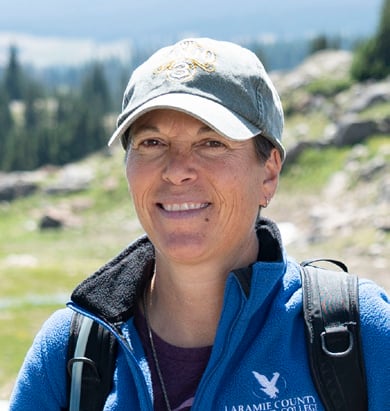

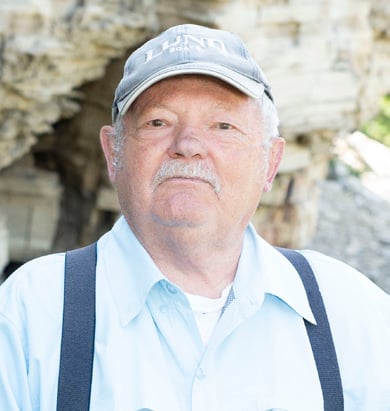
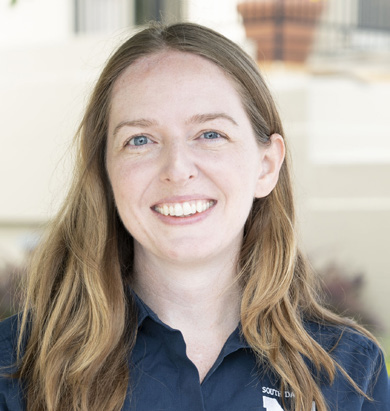
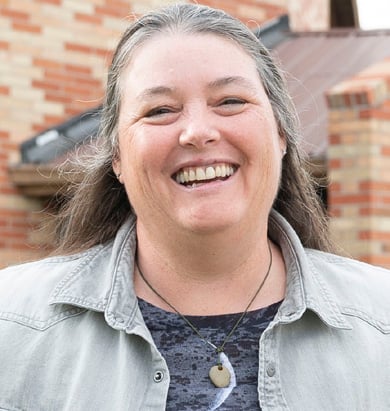
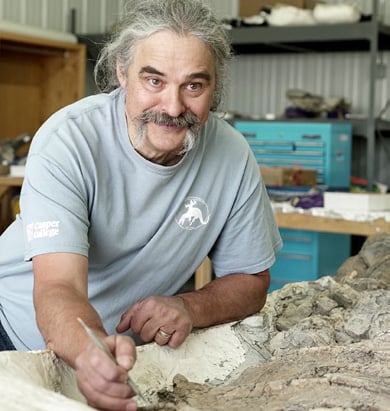
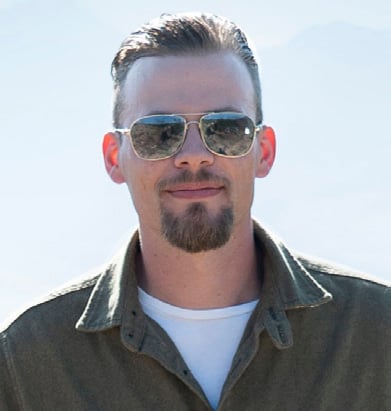
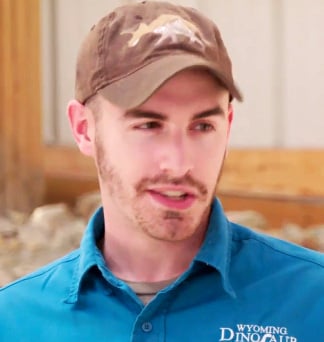
Guiding Questions
Download Guiding Questions|
Episode 1: |
Essential Question: |
Essential Question: How has life evolved on Earth? How do we know? |
Essential Question: |
|
Chapters |
Guiding Question(s): |
Guiding Question(s): |
Guiding Question(s): |
|---|---|---|---|
|
Introduction |
|||
|
Welcome to Fossil Country |
In what ways is the story of Earth recorded in the rocks? |
Why is it important to examine many different areas of science, such as geology, paleontology, and biology, in order to understand Earth’s past? |
|
|
Early Hints of Life |
Cyanobacteria are also called blue green algae. What type of environment does algae live in? What does this make you think the area of the Medicine Bow Mountains was like millions of years ago? |
In what ways did cyanobacteria change the environment to allow for other forms of life to evolve? How might life on Earth look very different today if cyanobacteria did not exist millions of years ago? |
|
|
Something’s Fishy in Central Montana |
At Bear Gulch, common fossil discoveries include sharks, fish, and invertebrates. Based on the types of organisms that lived here millions of years ago, what do you think the environment looked like then? Why do some layers of the fossil record have more specimens than others? What factors contribute to making some places on Earth more fossil-rich than others? What environmental factors of the past do you think contribute to fossil-rich areas? |
How do processes and tools help researchers study fossils in the field? What do you think keeps scientists searching for more fossils even in sites that have been excavated for years? In what ways does each new discovery yield unique information about the past? How does new technology allow scientists to build on the research of past generations of scientists? What unanswered questions might new technology help answer in the future? |
|
|
The Bone Wars |
What types of fossilized animal remains are commonly discovered at the Morrison Formation? Based on these animals, what do you think this environment looked like millions of years ago? |
Is science competitive or collaborative? How did scientists who studied the Morrison Formation interact in the past? How do they interact today? Why do you think this has shifted? How have people who are not formally trained scientists contributed to our collective understanding of the past? How might you contribute? |
|
|
Time of the Titans |
Why do you think there were so many different species of sauropods that existed millions of years ago? Why do you think they existed for such a long time? What specific adaptations do you think made this type of dinosaur so successful? |
Why is science always a work in progress? How does new technology allow scientists to build on the research of past generations of scientists? What unanswered questions might new technology help answer in the future? |
|
|
Traces of Discovery |
Think about a time you left footprints behind when you walked. What conditions or terrain features lead to imprints being made? What do you think the environment was like millions of years ago in places where fossilized tracks have been discovered? |
How can fossilized tracks (and other trace fossils) tell us about how an organism of the past behaved? What can trace fossils reveal that fossilized bone cannot? |
How have people who are not formally trained scientists contributed to our collective understanding of the past? How might you contribute? In what ways does current research continue to change what we understand about the past? What different types of people make up the scientific community? |
Episode 2: We Dig Dinosaurs
Cruise into the Cretaceous, when astonishing creatures such as T. rex dominated the planet. But what happened to these tremendous animals? And how did other life forms survive an apocalyptic asteroid that crashed into Earth 66 million years ago?
Scientist Spotlight
On her travels, Emily meets many people who together make up the scientific community. Here are the people she encounters along the second leg of her journey.
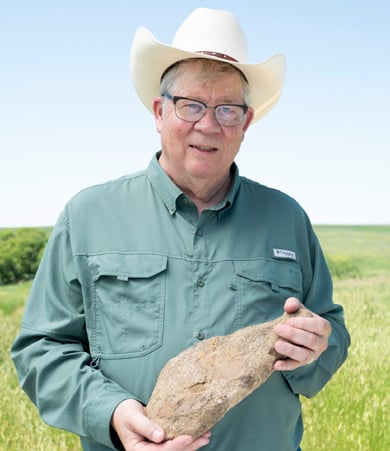

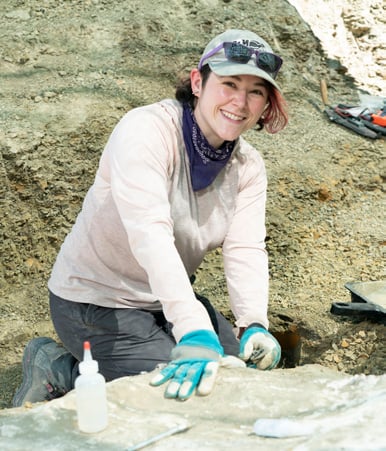
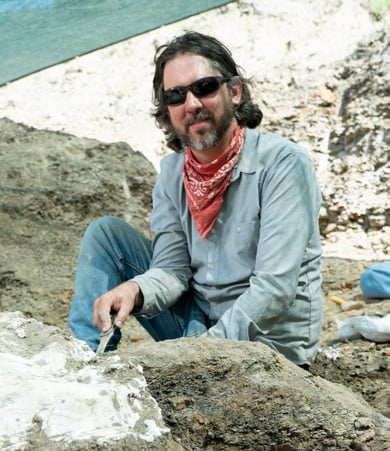
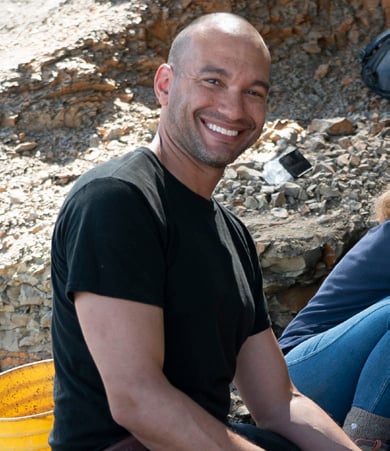
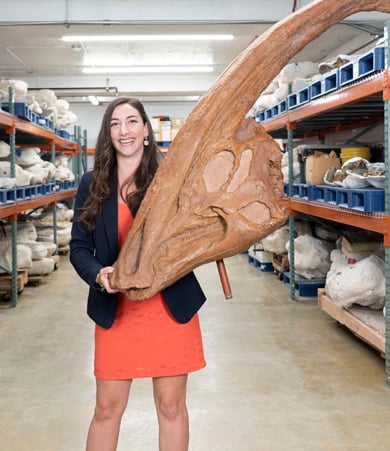
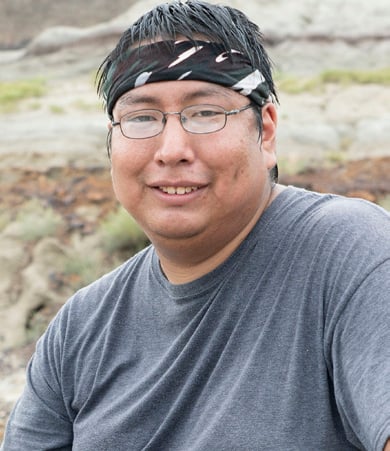
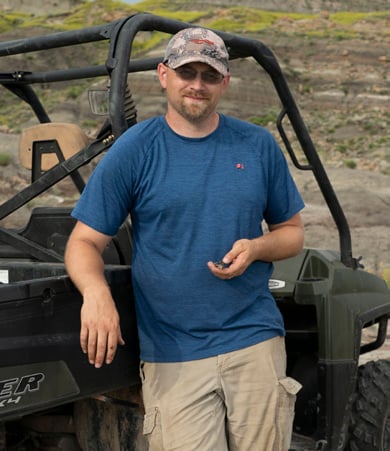
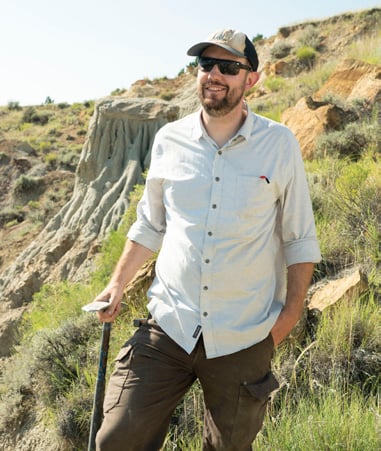
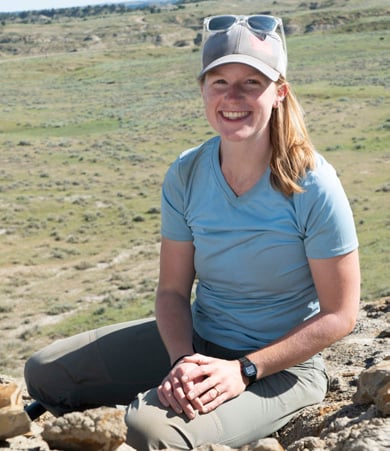


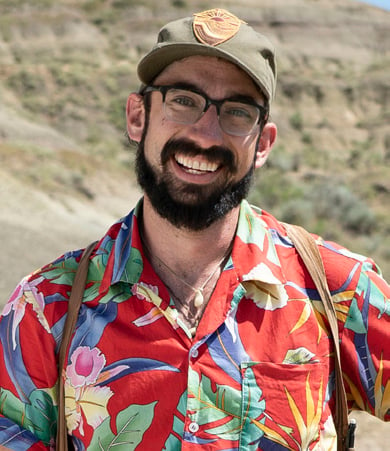
Guiding Questions
Download Guiding Questions|
Episode 2: |
Essential Question: |
Essential Question: |
Essential Question: |
|
Chapters |
Guiding Question(s): |
Guiding Question(s): |
Guiding Question(s): |
|---|---|---|---|
|
Introduction |
|||
|
SUE, Lee, and Me |
What types of fossils have been discovered in the Midwest? What do you think the environment looked like millions of years ago? How does this compare to what it looks like today? |
In what ways does science impact your life? How can people engage in and be inspired by science even if they don’t have a degree in science? What is the process of excavating a fossil from discovery to display? What are the benefits and limitations of displaying fossils as reconstructed, articulated skeletons? What are the benefits and limitations of displaying a fossil in matrix as it was found? |
|
|
Highway to Hell Creek |
What kinds of information can be determined about a fossil just by knowing the strata that it came from? What factors contribute to making some places on Earth more fossil-rich than others? What environmental factors of the past do you think contribute to fossil-rich areas? Based on the types of fossils found in the Hell Creek Formation, what do you think the environment looked like millions of years ago? |
How did Triceratops’ physical traits allow it to survive so well and for so long in its environment? In what ways did Triceratops’ features evolve over time? How do you think these evolved features allowed triceratops to survive more successfully? In what ways are some of the organisms that lived millions of years ago in the Hell Creek Formation similar to animals that are alive today? What features do you think helped these species survive so successfully? |
How do tools, strategies, and processes inform the research of paleontology? What tools are used to excavate fossils in the field? What strategies and processes are used to excavate fossils in the field? What are the benefits of creating and storing collections of fossils? What can collections of fossils reveal about the past that individual specimens cannot? How does new technology change our understanding of the past, even when it is used to examine fossils that may have been collected a very long time ago? |
|
The Day the Dinosaurs Died |
In what ways can strata reveal information about the living and nonliving elements of environments in the past? Why do some layers of the fossil record have more specimens than others? What types of fossilized remains are commonly discovered before and after the K-Pg boundary? Based on these organisms, what do you think this environment looked like before and after this extinction event? |
What types of organisms were able to survive the mass extinction caused by the impact of the asteroid? What features or behaviors do you think allowed these organisms to survive? What types of organisms were not able to survive this mass extinction? What features or behaviors do you think contributed to these species’ extinction? What might diversity or lack of diversity in plant fossils in an area tell you about the other aspects of an ecosystem in the past? |
What tools are used to excavate fossils in the field? What strategies and processes are used to excavate fossils in the field? |
|
Survivors ofthe Apocalypse |
What types of organisms were able to survive the mass extinction caused by the impact of the asteroid? What features or behaviors do you think allowed these organisms to survive? |
What makes a scientific discovery significant? Who can make a significant contribution to science? In what ways are fossils further analyzed after they have been brought in from the field? |
|
|
Dino Shindig |
How do people work together to build our collective understanding of Earth’s history? |
Episode 3: Tiny Teeth, Fearsome Beasts
As her journey takes her closer to the present day, Emily discovers surprising truths written in the fossil record. Meanwhile, scientists studying our planet’s past are revealing clues about its future.
Scientist Spotlight
On her travels, Emily meets many people who together make up the scientific community. Here are the people she encounters along the final leg of her journey.
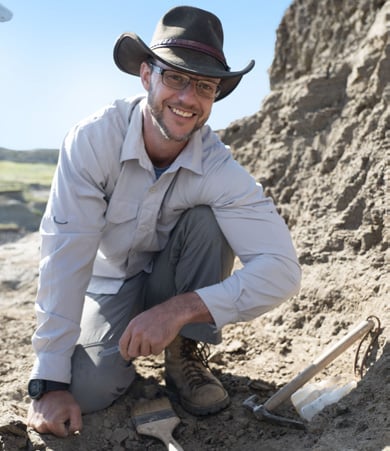
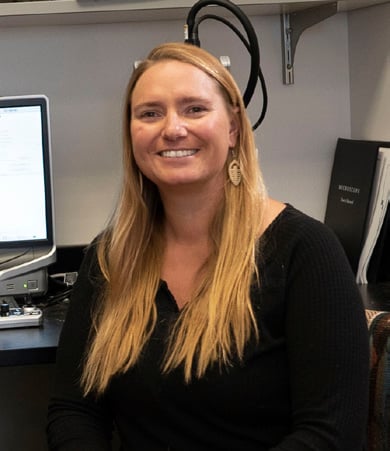
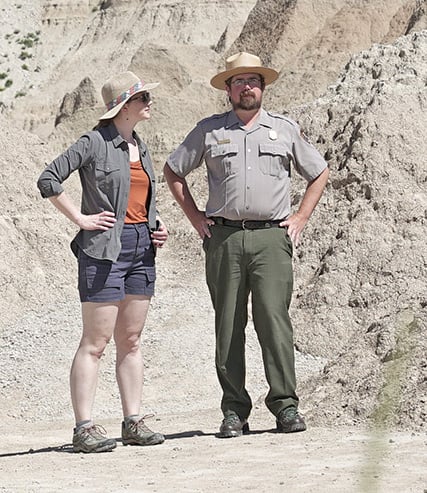

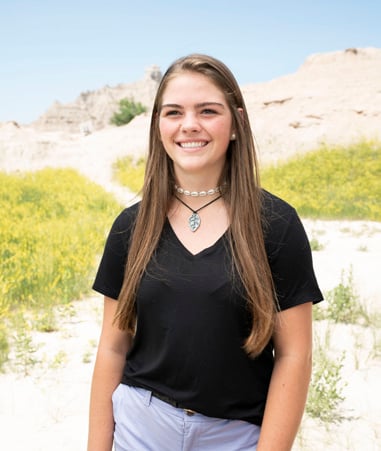
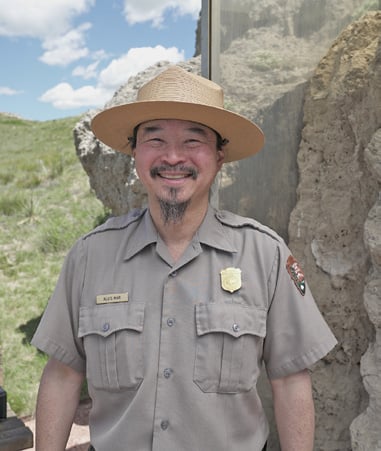
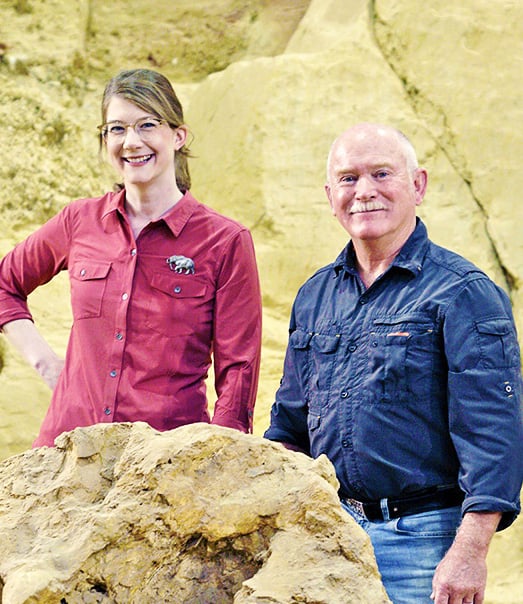
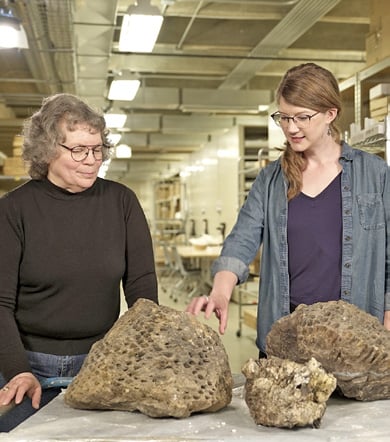
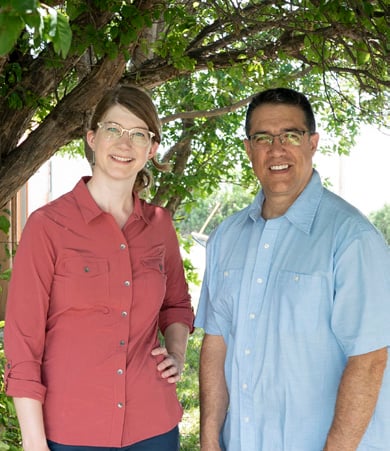
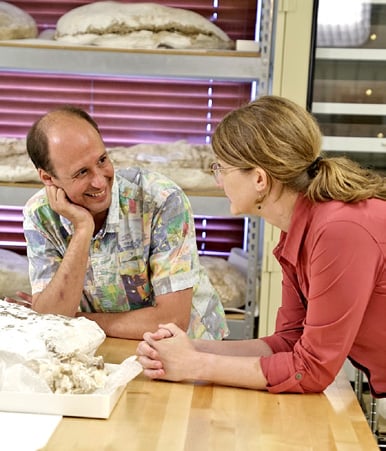
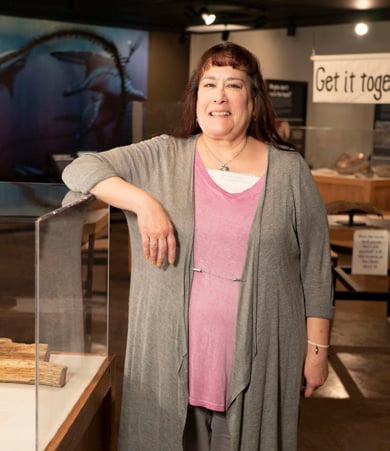
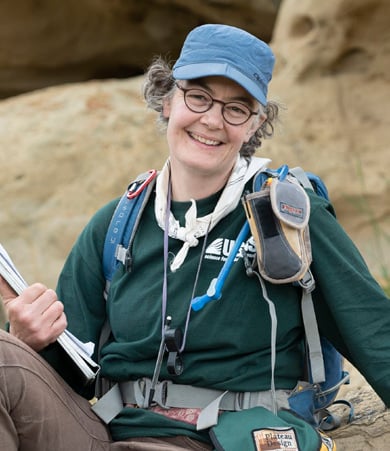
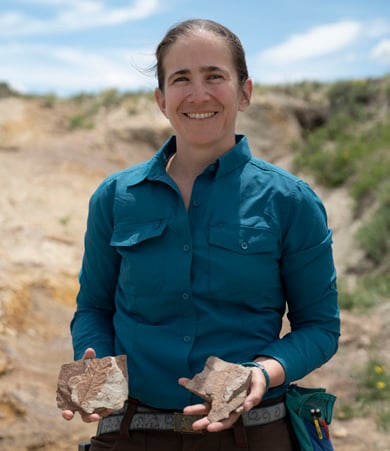
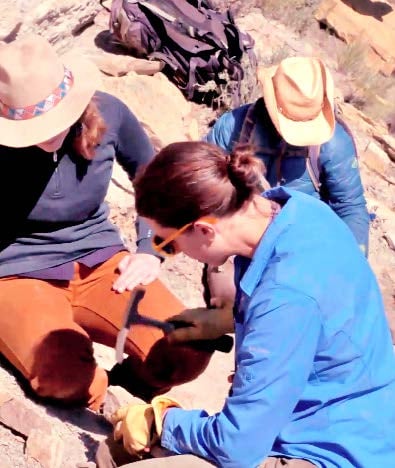

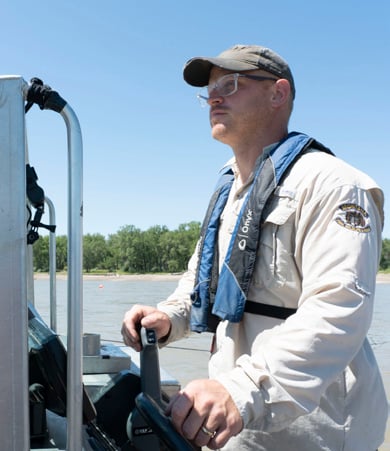
Guiding Questions
Download Guiding Questions|
Episode 3: |
Essential Question: |
Essential Question: |
Essential Question: |
|
Chapters |
Guiding Question(s): |
Guiding Question(s): |
Guiding Question(s): |
|---|---|---|---|
|
Introduction |
|||
|
Tiny Teeth, Fearsome Beasts |
What can fossilized teeth reveal about the environment that an animal lived in? |
What kinds of traits evolved in animals after the asteroid extinction event? How do you think these traits helped them survive in a post-mass extinction world? |
What tools are used to excavate fossils in the field? What tools and technology are used to study fossils in the lab? |
|
Discovery in the Badlands |
What did the Midwest look like at different times in the past? In what ways does the fossil record reveal what the environment looked like millions of years ago? |
What types of traits are common between modern animals in the Midwest and their ancestors? In what ways do these traits help the animals survive? What traits of ancient animals are no longer found in animals of the Midwest? In what ways might those traits no longer be suitable for the environment today? |
In what ways might people who are not scientists contribute to the scientific community? In what ways might people hinder scientific progress? |
|
Miocene Menagerie |
What types of information can trace fossils reveal about the environment, climate, and weather in the past? In what ways do fossilized organisms reveal what the environment was like in the past? |
What can trace fossils tell us about the traits and behaviors of animals from the past? |
Why is science always a work in progress? |
|
A Mammoth Surprise |
What types of environmental conditions in the past might contribute to sites with a high density of fossils? What did the environment around the Mammoth Site of Hot Springs look like millions of years ago? |
What mammoth traits and behaviors contributed to so many fossils being found at the Mammoth Site of Hot Springs? |
In what ways can people who are not scientists make significant contributions to the scientific community? |
|
The Lost Monument |
In what ways can plant fossils reveal information about the environment and climate in the past? What does the presence of fossil cycads suggest the environment and climate were like in the Midwest millions of years ago? |
How are cycads similar to or different from plants in the Midwest today? |
In what ways might different approaches to science be helpful or harmful to our collective understanding of the past? What are the benefits and drawbacks of keeping fossils where they are found? What are the benefits and drawbacks of moving fossils to collections or labs? |
|
The Value of Fossils |
How can multiple viewpoints or perspectives strengthen our collective understanding of science and scientific inquiry? In what ways do you think the culture of science can improve to ensure the inclusion of all people? |
||
|
Climate Change inthe Fossil Record |
In what ways can paleontology contribute to our understanding of how Earth’s environments and climate may change in the future? In what ways can plant fossils reveal information about the environment and climate in the past? |
How are animals and plants connected in an environment? What might happen to animal populations in an environment if the plants change over time? |
|
|
Earth’s Next Chapter |
In what ways can paleontology contribute to our understanding of how Earth’s environments and climate may change in the future? |
In what ways are human activities affecting the survival of other species? |
Why is science always a work in progress? How can science influence the ways that people make responsible decisions regarding Earth’s future? |
Glossary
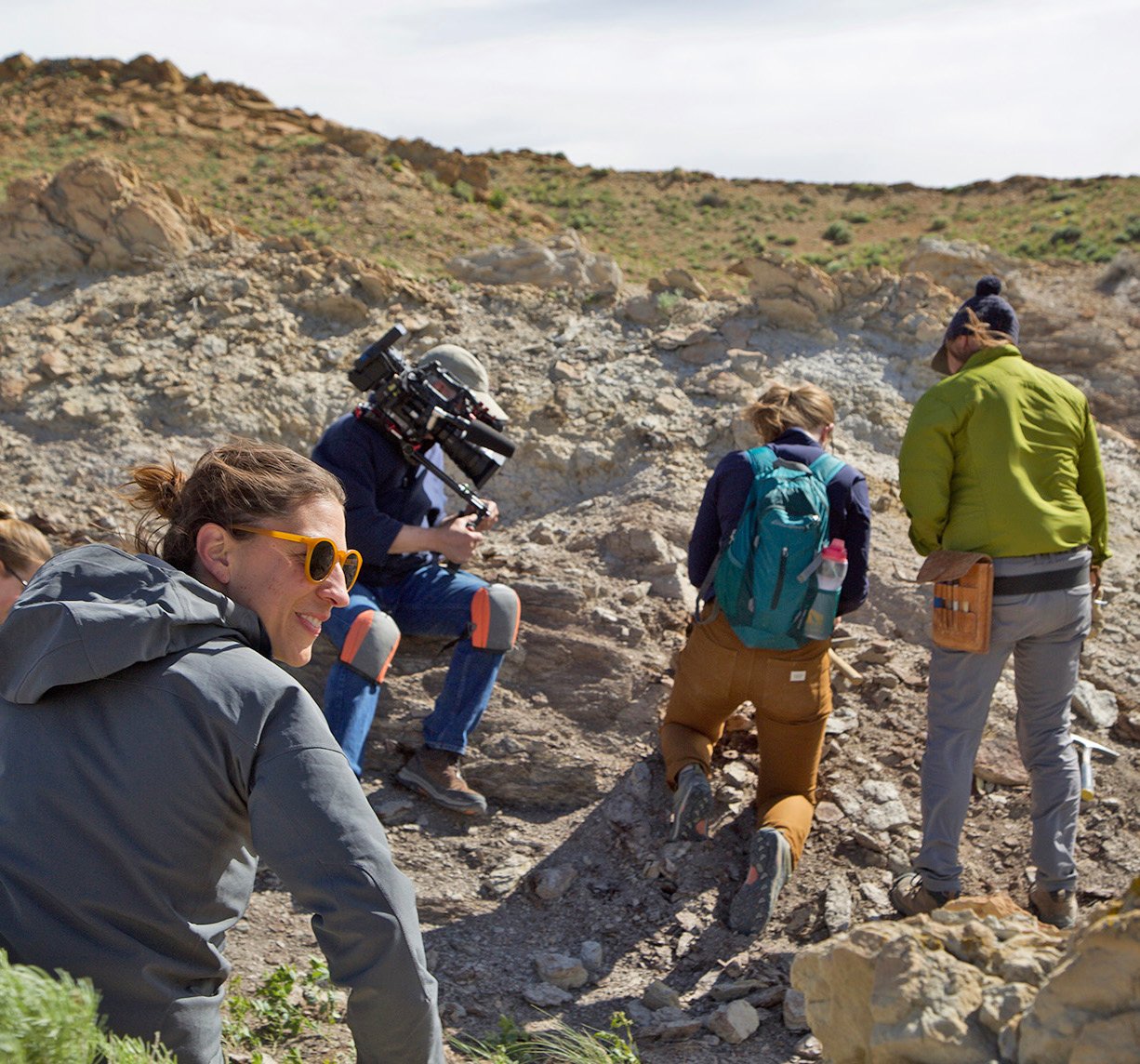
Photo: Raven Forrest/WTTW
Angiosperm – a flowering, fruit-bearing plant or tree
Cephalopod – any member of the molluscan class Cephalopoda, such as a squid or nautilus
Cyanobacteria – a division of microorganisms that are related to bacteria but are capable of photosynthesis
Cycad – a palm-like plant of tropical and subtropical regions, bearing large male or female cones.
Edmontosaurus – a duck-billed dinosaur
Histology – the study of the microscopic structure of tissues
K-Pg (Cretaceous-Paleogene) Boundary – the geologic signature marking the end of the Cretaceous period and the mass extinction of all non-avian dinosaurs
K-T (Cretaceous-Tertiary) Boundary – former term for the Cretaceous-Paleogene(K-Pg) Boundary
Microsite – a high-density accumulation of small fossils
Morphology – the study of the form and structure of plants and animals
Native American Graves Protection and Repatriation Act – law requiring institutions to repatriate human remains and cultural items to affiliated tribes and descendants
Non-avian – not of or relating to birds
Paleontology – the study of fossils and the evolution of life on Earth.
Palmate leaf – a leaf having several lobes (typically 5–7) whose midribs all radiate from one point.
Pinnate leaf – a leaf having leaflets arranged on either side of the stem, typically in pairs opposite each other
Plesiadapis – one of the oldest known primate-like mammal genera which existed approximately 55-58 million years ago
Plesiosaur – a Mesozoic marine reptile
Stratigraphy – a branch of geology concerned with the study of rock layers (strata) and layering
Stromatolites – sedimentary rocks formed by layers of single-celled bacteria
Taphonomy – the branch of paleontology that deals with the processes of fossilization
Theropods – a species of dinosaurs that is characterized by hollow bones and three-toed limbs
Trace fossil (ichnofossil) – the fossilized record of biological activity, such as footprints
Triceratops – a herbivorous, three-horned dinosaur
VinacTM (polyvinyl acetate) – an adhesive often used to preserve fossils
Resources
Read
Older Than Dirt: A Wild but True History of Earth by Don Brown and Dr. Mike Perfit
Two dirt-loving animals explore the major events in the history of the Earth in a graphic novel format.
A History of Life in 100 Fossils by Paul D. Taylor andAaron O’Dea
The epic story of life on Earth, uniquely retold through some of the most significant fossils ever found. The book travels through 3.5 billion years of Earth’s history and across all seven continents, showcasing the unusual and wonderful creatures that have played a pivotal role in our evolutionary past.
Boy, Were We Wrong About Dinosaurs! by Kathleen V. Kudlinski
An engaging introduction to the nature of science through the lens of dinosaur discoveries.
The travels of a paleontologist and an artist as they drive across the American West in search of fossils. Throughout their journey, they encounter “paleonerds” like themselves, people dedicated to finding everything from suburban T. rexes to ancient fossilized forests.
The continued travels of a paleontologist and artist – driving, flying, and boating their way from Baja, California to northern Alaska in search of the fossil secrets of North America’s Pacific coast. They hunt for fossils, visit museums, meet scientists and paleonerds, and sleuth out untold stories of extinct worlds.
Watch
Earth’s Entire History (Visualized On A Football Field)
NPR’s Skunk Bear uses the yard lines on a football field to map out our planet’s past (and humanity’s tiny moment in it).
The Brain Scoop: “Paleoart: Painting the Land Before Time”
Learn about artists who worked to bring prehistoric animals and landscapes to life!
Join hosts Hank Green, Kallie Moore, and Blake de Pastino as they take you on a journey through the history of life on Earth, from the dawn of life in the Archaean eon through the Mesozoic era – the so-called “Age of Dinosaurs” – right up to the end of the most recent Ice Age.
Paleontologists are constantly learning new things about T. rex because they find new ways of investigating the fossils. Watch this video to see how our view of T. rex has changed in the past 100+ years.
NOVA: “Day the Dinosaurs Died” (S44 E21)
Sixty-six million years ago, a seven-mile-wide asteroid collided with Earth, triggering a chain of events that coincide with the end of the dinosaurs. But experts have long debated exactly what happened when the asteroid struck and how the giant beasts met their end. Now scientists have uncovered compelling new clues about the catastrophe.
NOVA: “Rise of the Mammals” (S46 E17)
Sixty-six million years ago, an asteroid wiped out the dinosaurs in a fiery, global catastrophe. But we know little about how their successors, the mammals, recovered and took over the world. Now, hidden inside ordinary-looking rocks, an astonishing trove of fossils reveals a dramatic new picture of how rat-sized creatures ballooned in size and began to evolve into the vast array of species.
The Brain Scoop: “What Fossils Reveal about Today’s Climate Change”
Emily Graslie talks with Dr. Scott Wing about how studying the fossil record helps us better understand current impacts of human-caused climate change on our planet and what it means for our future world.
What is it really like to go on an expedition and search for fossils? See for yourself as our paleontologists roll up their sleeves and get their hands dirty in this quick guide.
The Brain Scoop: “Fossil Myths: Cyclopes, Griffins,and Magic Fairy Bread”
Before modern science, what evidence did people use to help explain the inexplicable?
For some things – the fossil record!
The Brain Scoop: “Tully Monster Mystery Solved”
For decades, it was thought the “Tully monster” – a bizarre animal that lived 307 million years ago – was an invertebrate, like a kind of worm. But Field Museum scientists helped finally crack the mystery of the monster to reveal it’s actually related to lamprey fish.
The Brain Scoop:“In Search of Fossil Fish”
Join Emily Graslie on a fishing trip for 52-million-year-old fossils! The first in a series about the excavation of Fossil Lake, Wyoming.
Do
Engage with a virtual 3D model of SUE the T. rex
Contribute to ongoing research through a community science project on paleobotany
Become a Junior Paleontologist through the National Park Service Junior Ranger Program.
References
1. NGSS Lead States. 2013. Next Generation Science Standards: For States, By States. Washington, DC: The National Academies Press.The Educator’s Guide for Prehistoric Road Trip was created in partnership with The Field Museum and WTTW Chicago.

